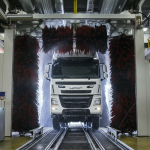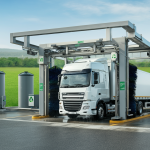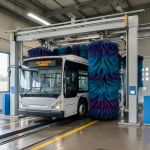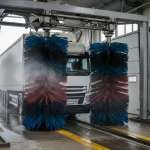The rumble of diesel engines and the hiss of high-pressure water have long been the soundtrack of America’s truck wash facilities. But step into a modern truck wash today, and you’ll hear something new: the quiet hum of automation working alongside human expertise. The traditional hand wash truck wash industry is undergoing a dramatic transformation, one that’s reshaping how operators run their businesses and how drivers experience the essential service of keeping their rigs clean.
The Perfect Storm of Change
For decades, truck washing was a purely manual endeavor. Teams of workers would spend 45 minutes to an hour meticulously cleaning each vehicle, wielding brushes, soap, and determination against road grime, salt, and diesel soot. While this approach delivered quality results, it came with inherent limitations: inconsistent timing, weather dependency, labor challenges, and bottlenecks that left drivers waiting in long queues.
The convergence of several factors has created the perfect conditions for automation to flourish in this industry. Rising labor costs, increasing demand for faster turnaround times, and the growing complexity of modern commercial vehicles have pushed operators to seek technological solutions. Meanwhile, advances in robotics, sensor technology, and automated systems have made sophisticated truck wash automation both feasible and affordable.
Quality Through Precision
One of the most compelling advantages of automation in truck washing is the dramatic improvement in consistency and quality. Automated systems don’t get tired, distracted, or rush through the final rinse. They apply the same precise pressure, use the exact amount of cleaning solution, and follow identical patterns every single time.
Modern automated truck wash systems use advanced sensors to map each vehicle’s contours, adjusting spray patterns and brush positions to ensure complete coverage. This level of precision means that hard-to-reach areas like wheel wells, undercarriages, and the spaces between trailer tandems receive the same thorough attention as more accessible surfaces. The result is a level of cleaning consistency that even the most skilled manual wash teams struggle to match across dozens of vehicles per day.
The automation also enables the use of specialized cleaning solutions and techniques that would be impractical or unsafe for manual application. Automated systems can precisely control chemical concentrations, apply heated solutions at optimal temperatures, and use high-pressure jets in ways that maximize cleaning effectiveness while minimizing waste.
Speed Revolution
Perhaps nowhere is the impact of automation more immediately apparent than in wash speed. What once took 45-60 minutes of manual labor can now be completed in 15-25 minutes through automated systems. This isn’t just about moving faster – it’s about eliminating the variables that create delays in traditional hand washing.
Automated systems can begin working immediately upon a truck’s arrival, without the need to assemble a crew or wait for equipment setup. Multiple automated stations can operate simultaneously on different parts of the vehicle, with robotic arms cleaning the cab while automated gantries handle the trailer. The precision of automation also eliminates the need for time-consuming touch-ups and rework that often extend manual wash times.
This speed improvement cascades through the entire operation. Faster individual wash times mean higher throughput, reduced wait times, and the ability to serve more customers throughout the day. For truck wash operators, this translates directly into increased revenue potential and improved customer satisfaction.
The Profitability Equation
The economics of truck wash automation tell a compelling story. While the initial investment in automated systems can be substantial, the long-term financial benefits are transformative. Labor costs, which typically represent 40-50% of a truck wash operation’s expenses, can be dramatically reduced through automation.
Automated systems also deliver superior resource efficiency. Precise control over water usage, chemical application, and energy consumption means less waste and lower operating costs. Many automated systems include water recycling capabilities, further reducing both costs and environmental impact.
The increased throughput enabled by automation creates a multiplier effect on profitability. A facility that can wash 50% more trucks per day with the same footprint and lower variable costs per wash sees exponential improvements in profit margins. This enhanced profitability also provides operators with more resources to invest in facility improvements, additional services, and better customer amenities.
The Driver’s Perspective: Speed Meets Convenience
For truck drivers, the benefits of automation extend far beyond just faster wash times. The predictability of automated systems means drivers can plan their schedules more effectively, knowing exactly how long their wash will take. This is particularly valuable for drivers operating under strict hours-of-service regulations, where every minute counts.
The reduced wait times are perhaps the most appreciated benefit. Instead of queuing for an hour or more during peak times, drivers at automated facilities often experience minimal delays. Some advanced facilities even offer scheduling systems that allow drivers to reserve wash times, further eliminating unpredictable wait periods.
Automated systems also provide a more comfortable experience for drivers. They can remain in their cabs during much of the wash process, avoiding exposure to harsh weather conditions and chemical overspray. Many automated facilities include climate-controlled waiting areas with amenities like WiFi, food service, and driver lounges, transforming the truck wash from a necessary chore into a welcome break.
Fleet Operators Embrace Efficiency
Fleet operators have quickly recognized the advantages of automated truck washing for their operations. The speed and consistency of automated systems allow for more predictable maintenance scheduling and improved fleet appearance standards. When every truck receives the same high-quality wash in a predictable timeframe, fleet managers can better coordinate washing with other maintenance activities.
The detailed reporting capabilities of many automated systems also provide valuable data for fleet optimization. Operators can track wash frequency, identify patterns in soil accumulation, and optimize their cleaning schedules based on actual data rather than estimates. This data-driven approach to fleet maintenance helps reduce costs while improving vehicle presentation and compliance with cleanliness regulations.
The Human Element Remains
Despite the dramatic improvements automation brings, the most successful truck wash operations recognize that technology works best when combined with human expertise. Automation handles the repetitive, physically demanding aspects of truck washing, freeing staff to focus on quality control, customer service, and specialized services that require human judgment.
Many facilities employ hybrid models where automated systems handle the primary washing process while trained staff perform final inspections, handle special requests, and provide personalized service. This approach combines the efficiency and consistency of automation with the flexibility and problem-solving capabilities that only human workers can provide.
Looking Forward
The automation revolution in truck washing is still in its early stages, with new technologies and capabilities emerging regularly. Advanced sensor systems are becoming more sophisticated, artificial intelligence is being integrated for predictive maintenance and optimization, and robotic systems are becoming more versatile and capable.
Future developments may include fully autonomous truck wash facilities that can operate with minimal human oversight, integrated systems that connect directly with fleet management software, and advanced recycling systems that make truck washing increasingly environmentally sustainable.
The Road Ahead
The transformation of America’s truck wash industry through automation represents more than just technological advancement – it’s a fundamental shift toward efficiency, consistency, and customer satisfaction. For truck wash operators, automation offers a path to increased profitability and competitive advantage. For drivers and fleet operators, it delivers the speed, quality, and convenience that modern logistics demands.
As this technology continues to evolve and proliferate, the truck wash industry is positioning itself for a future where clean trucks, satisfied customers, and profitable operations go hand in hand. The road ahead is clear, and it’s being paved with the precision, speed, and reliability that only automation can deliver.
The transformation is already underway, and those who embrace it are discovering that the future of truck washing isn’t just automated – it’s optimized for success in an increasingly competitive and demanding industry.




